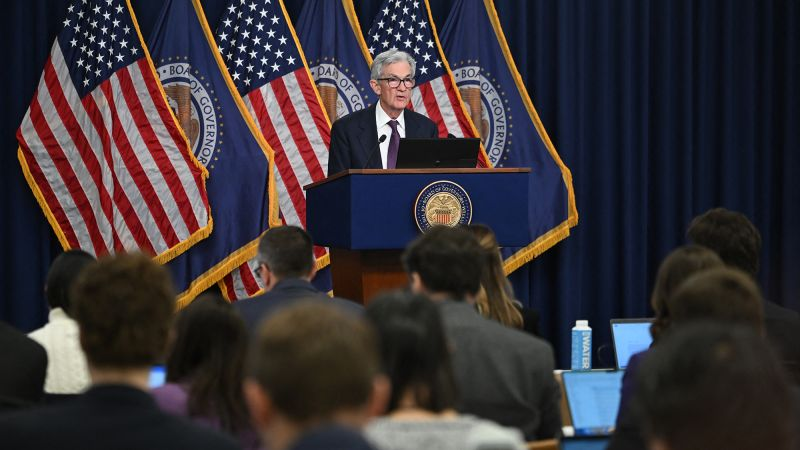6 Posts Sort By
Latest
Oldest

US stocks were mixed Wednesday as investors prepare for the Federal Reserve’s first rate decision of the year.
The Dow opened higher and gained around 75 points, 0.17%, in morning trading. The S&P 500 opened lower and was down 0.15%. The Nasdaq Composite opened lower and slid 0.38%.
Investors expect the Fed to hold interest rates steady after three consecutive decisions to cut rates.
Economic data shows cooling inflation and low unemployment, meaning the Fed can likely pause on cutting rates for a bit.
“We do not expect a change in rates, but Chair Powell will likely use the press conference to set expectations about future rate cuts,” said Jeffrey Roach, chief economist at LPL Financial, in an email.
“Financial markets will be keen to hear how the Trump administration’s policies are changing the Fed’s outlook for growth and inflation following the wave of executive orders announced after the inauguration,” said Bill Adams, chief economist at Comerica Bank, in a note.
The yield on the 10-year Treasury note edged lower and the dollar gained Wednesday morning.
The sentiment driving markets was neutral after being in fear territory for most of January, according to CNN’s Fear and Greed Index.
Tech giants Meta and Microsoft are both expected to report earnings this afternoon after the closing bell. Tesla is also expected to report earnings after the bell.

Financial markets finally got a taste of long-awaited rate cuts in 2024 — but 2025 is already shaping up to be a less than satisfying year.
Traders are pricing in a 99.5% certainty that the Federal Reserve will pause on any rate moves this month, holding its benchmark lending rate at a range of 4.25% to 4.50%.
After inflation slowed last year, Fed officials rolled out three rate cuts in a row, starting in September. But sticky inflation has foiled that plan, putting the central bank back into a holding pattern.
Now, economists are warning that President Donald Trump’s tariff threats, mass deportation policies and his focus on boosting domestic oil production could end up further stoking inflation.
“Inflation remains elevated near 3 percent and has shown little progress toward the 2 percent target in more than a year. Uncertainty about prospective policy changes that could be inflationary add another layer of concern,” said Bankrate’s chef financial analyst Greg McBride in a note this week.
Consumers and traders are waiting to learn if the Fed’s expected pause today is a one-meeting hold or the start of a longer stretch. Either way, the focus will be on Federal Reserve Chair Jerome Powell’s post-meeting comments on rates, the Trump administration and the central bank’s projections for 2025.

At the start of every year, the officials who vote on monetary policy decisions change. That’s because the Federal Open Market Committee, the 12-person group of Fed officials who vote on where interest rates should be, is structured such that seven people on the Fed’s Board of Governors, which includes Chair Jerome Powell, and the president of the New York Fed get a vote every year. The remaining four voters are presidents of one the other 11 regional Fed banks, which rotate annually.
In effect, this means that one-third of the rate-setting committee changes each year. And that matters because different Fed officials have differing views on where interest rates should be. For instance, at December’s meeting, Cleveland Fed President Beth Hammack dissented from the other 11 voters by favoring a rate pause rather than the quarter-point cut that occured.
However, Hammack will now serve as an alternate voter at meetings this year. While Richmond Fed President Tom Barkin, Atlanta Fed President Raphael Bostic and San Francisco Fed President Mary Daly, all of whom voted on interest rate decisions last year, won’t have any opportunity to vote at meetings this year.
The new regional Fed bank president voters are Susan Collins from Boston, Austan Goolsbee from Chicago, Alberto Musalem from St. Louis and Jeffrey Schmid from Kansas City.
All four appear to currently support a rate pause and a gradual approach to any potential cuts moving forward. For instance, Goolsbee, who spent much of last year advocating for rate cuts, has more recently indicated the central bank can afford to be more patient with continuing to cut given the strength of the labor market. In remarks from earlier this month, Collins said she supports a similar approach, noting that she backed the Fed’s decisions to cut rates in November and December.
After slashing its key interest rate by a full percentage point last year, the Federal Reserve on Wednesday is expected to kick off a holding pattern that could last throughout the spring.
The reason: There hasn’t been much improvement on the inflation front over the past few months as fears over the job market’s health have faded. That means the Fed doesn’t have to be in any rush to cut rates — since it seems the US economy is successfully withstanding elevated borrowing costs — allowing central bankers to stand pat as they await for inflation to slow further.
In December, Fed officials penciled in just two rate cuts for this year, down from the four they projected in September, mostly because of higher-than-expected inflation readings.
For the Fed to begin cutting again, officials will have to see inflation continue to drift closer to the central bank’s 2% target. Fed policymakers seem to expect that to be the case, according to their recent speeches, but unexpected rough patches have happened.
“It just hinges on the data,” Fed Governor Christopher Waller told CNBC earlier this month. “If the data doesn’t cooperate, then you’re going to be back to two, maybe even one if we just get a lot of sticky inflation.”

Every major bank on Wall Street is in agreement: A cut at this month’s meeting is a no-go.
But that’s about all they can agree on when it comes to the number of cuts each believes the Federal Reserve will deliver this year after December’s unexpectedly hot jobs report, which showed US employers hired 256,000 new workers, versus the 153,000 gains economists were expecting. Additionally, the unemployment rate fell from 4.2% to 4.1%.
At the high end, Citibank economists are penciling in a total of five quarter-point cuts this year, with the first of those coming as soon as May’s monetary policy meeting.
“We still see potential for softer jobs readings in upcoming data,” economists from the bank said in a note to clients after the December jobs report was released earlier in the month. “While the labor market is holding up better than we had expected, price and wage inflation are both cooling and should have officials comfortable cutting even in a still-strong economy,” they added.
Meanwhile, Bank of America and BNP Paribas economists don’t foresee the Fed lowering rates any further this year.
Labeling the December jobs report as “gangbusters,” Bank of America economists said in a note earlier this month that “given a resilient labor market, we now think the Fed cutting cycle is over.”

President Donald Trump hasn’t been shy about letting his views on the economy and the Federal Reserve be known.
Trump last week falsely claimed he has the ability to control borrowing costs, saying “with oil prices going down, I’ll demand that interest rates drop immediately” in his speech at the World Economic Forum annual meeting in Davos, Switzerland. Interest rates are broadly determined by market forces, which are influenced in large part by economic trends and the anticipated decisions of central banks.
In that same speech, he also mischaracterized the recent bout of inflation that erupted in 2021, claiming that it was a “record” high and that it was solely due to the policies of the Biden administration. In June 2022, the closely watched Consumer Price Index reached a 40-year high of 9.1%, well below the all-time high of of 23.7% set in 1920, the result of pandemic-fueled shocks to demand and supply. CPI rose 2.9% in December from a year earlier.
The president also called on foreign oil producers OPEC and Saudi Arabia to bring down oil prices, which are influenced by production levels. OPEC, a foreign cartel that competes directly with the US oil industry, has restrained production in response to weaker demand.
Later that same day he spoke in Davos, Trump also doubled down on his criticism of the Fed and its current leader, Jerome Powell.
“I think I know interest rates much better than they do, and I think I know it certainly much better than the one who’s primarily in charge of making that decision,” Trump said, referencing Powell, while speaking with reporters from the Oval Office. “If I disagree, I will let it be known.”






